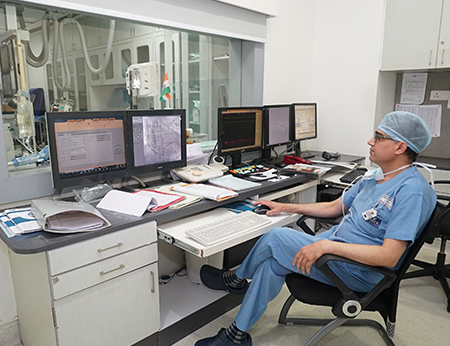Electro Physiology Studies

An electrophysiology study, commonly referred to as EP study, is a minimally invasive procedure that involves the use of catheters which are introduced in the blood vessels to map the electrical activity of the heart. The procedure is recommended to people with arrhythmia, a condition marked by abnormal heart rhythmsand various other heart problems so as to determine their cause and figure out a proper treatment plan that would yield the best results for the patient. The electrical activity of the heart is recorded when it is beating in a sinus rhythm so as to evaluate the conduction system and detect accessory pathways. This helps to locate the site as well as determine the cause of the arrhythmia. The test can also help to predict the risks of cardiac arrest thereby enabling the doctors to take the necessary measures to alleviate the same.
Indications for Electro Physiology Studies
Electro Physiology Studies help to determine the pattern in which electrical signals move throughout the heart. Some of the major indications of Electro Physiology Studies include:
- Different forms of arrhythmia (abnormal heart rhythm)such as atrial fibrillation, atrial flutter, tachycardia, ventricular tachycardia or supraventricular tachycardia.
- Cardiac ablation for treating arrhythmia. The procedure is performed to create scar tissue in the heart using heat or cold energy, so as to block ineffective or chaotic electric signals.
- Sudden and temporary unconsciousness i.e. syncope.
- Family or personal history of cardiac arrest.
How you prepare
- The patient’s overall health and heart conditionare evaluated to determine if he/she is eligible for the test.
- The doctors brief the patient about the whole procedure along with all the benefits and potential risks.
- The patient is required to fast for at least 12 hours prior to the test. In case the patient is on any medication, he/she is required to inform the doctor about the same and the latter will decide whether the dosage needs to be discontinued.
- Patients with an implanted heart device like a pacemaker or a cardioverter-defibrillator, need to inform their doctor about the same as special precautions may be required.
During an EP study
The procedure is initiated by administering some sedatives intravenously so as to help the patient to relax. Anaesthesia may also be used in certain cases if the doctors feel the need of the same. Once the patient is in a sedated state, a catheter with a special electrode on its tip is introduced via the groin or a small incision on the patient’s forearm or neck and guided towards the heart with the help of special x-ray imaging technique. The doctors may also use a contrast material that blocks the radiations for a clearer view. The electrodes help to send electrical impulses to the heart and record its electrical activity.
Doctors usually resort to one of the following techniques during the study:
- Taking the baseline readings of the heart’s electrical activity by placing the catheter in different locations and performing an intracardiac electrogram.
- Using a tiny electrode to artificiallyinduce abnormal heart rhythm by making the heart beat slightly faster or slower. This is followed by recording the heart’s reaction to stimuli. The electrode can be positioned in different parts of the heart to determine the source of abnormal heart rhythms.
- Infusing certain medicines to alter heart function by halting or alleviating the pace of electrical activity in particular areas of the heart and recording the hearts reaction to the same.
- Mapping the heart before cardiac ablation for pinpointing the best location for the treatment. The map, thus generated, is used during the procedure.
The type of test that you will be recommended to undergo depends upon the indication for which the test is being performed. If the doctor feels the need for performing cardiac ablation during your EP study, it may be performed simultaneously. In such cases, the procedure takes slightly longer time. Although the procedure is not painful, the patient might feel slight discomfort or pressure.
After an EP study
After the procedure, the patient is shifted to the recovery area for keen monitoring for about 4 to 6 hours. The patient is required to stay still to give the wound some time to heal and prevent bleeding at the site of insertion. Most of the patients are discharged on the same day while others might be required to stay at the hospital for a day.
Slight soreness at the site of incision is quite normal and fades within a day or two. Regular follow-ups are important if the soreness persists for long.
Risks
Some of the risks associated with an EP study include:
- Infection or bleeding at the site of insertion
- Damage to the blood vessels or heart valves
- Venous thromboembolism
- Slightly elevated risks of stroke and cardiac arrest
- Disrupted electrical system


